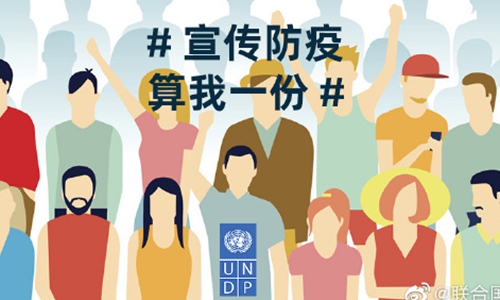Global netizens use imaginative means to participate in a UN-led campaign against COVID-19
Source:Global Times Published: 2020/3/8 14:13:40

Poster from UNDP Photo: Couresy of UNDP's Weibo
Chinese from different fields and ethnic minority groups as well as people from other countries actively joined the publicity initiative to prevent COVID-19 launched by the United Nations Development Programme (UNDP) and World Health Organization (WHO) on China's Twitter-like Sina Weibo."Even if you are not on the front line of the epidemic, you can still contribute to the epidemic battle," UNDP said in a post about the initiative on its official Sina Weibo account.
The international organization provided some health references about epidemic prevention from the WHO to Chinese netizens since mid-February, and encouraged people to join in the public event through various means including putting up posters in residential communities, translating related information into the languages of China's ethnic minorities and making videos in local dialects to help those who do not speak Putonghua (Standard Chinese).
The hashtag for the event had earned 28 million views as of Sunday.
Hundred of thousands of netizens from various provinces, ethnic minorities such as the Tibetan, Dai and Uygur ethnic groups, and countries around the world have recorded epidemic prevention videos in multiple dialects and languages.
Many Chinese celebrities including the famous pianist Langlang and well-known makeup bloggers have also use their celebrity charm to call for their fans to join in this event. Besides, with help from content platforms and studios like A Lab, answers and calls from China's online sensations like Li Xueqin and stylist Kevin have also been reposted by UNDP's official account
One of the most creative videos was one in a form of a news report hosted by an artificial intelligence presenter whose background information is shown in different languages.
Some organizations posted videos with their own special twists. For example, the Chengdu Research of Giant Panda Breeding shared a health tip video from the viewpoint of some cute pandas.
Some versatile netizens also have also disseminated epidemic prevention knowledge in other forms such as sign language, posters and comics.
Many netizens commented on Sina Weibo that it is was a rare sight to see professional health information spread across so many various channels and that they have passed the epidemic prevention information to their relatives and friends, especially the elderly at home.
Posted in: CELEBRITY,CULTURE & LEISURE